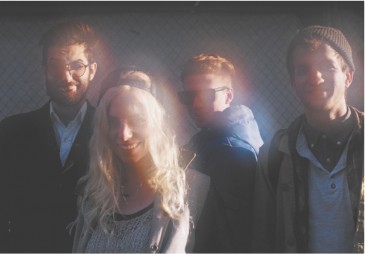
When I arrive early to meet World Club at an East Vancouver pub, I casually take a seat at the bar and place a drink order. “Comin’ in to work?” the man drinking next to me asks, mistaking me for an employee. “Kind of,” I say scanning the faces in the room, “I’m here to interview World Club.” A waitress with a burgundy coloured bob sets a pint down in front of me. “Who’s in the club?” he persists. I’m not exactly sure, so I say nothing and wait.
A while later, in walks a striking blonde accompanied by who I’m guessing are her three fellow bandmates. The blonde introduces herself as Janine Prevost, shakes my hand and invites me to take a seat at a glass table top framing an old map of the Georgia Strait. In a few minutes we’re joined by Tyler Dunn, Josh Harskamp, and Randy Szmek, who set their drinks down and take off their heavy coats. Together the four make up the uniquely experimental soundscape that is World Club.
Outside the autumn air is cool and calm, but inside the pub is warm and noisy with the banter of the Tuesday night crowd. The casually dressed foursome formally introduce themselves, spelling out their last names, which until then had been a mystery to me. They’re the type of artists who value privacy, more interested in being recognized by their sound than by the details of their personal lives. Together they’ve played all over Vancouver’s indie scene. From their basement beginnings to opening for Japandroids and touring across the United States, they’ve garnered a reputation without much self-promotion and without any official management.
Tuning out the sound of top 40 coming through the bar’s speakers and the loud chatter coming from adjacent tables, we settle into a discussion of Live-able Via-bility, the group’s most recent and most involved project to date. The idea for the collection came into fruition last February, just three weeks before recording at the Factory Studios in Vancouver with friend and audio engineer Hayz Fisher. In one session, the quartet recorded a continuous set, approximately 38 minutes long, then spent the following three months adding layers of samples and vocals over the master.
“It turned into way more of an intense project than we had originally decided it would be,” Szmek tells me, “We were calling it a mixtape at first.”
Harskamp adds, “by the time we were done, it felt more substantial than that, but it’s still not the World Club album. It’s not our first album, that’s coming, we’re working on that now.”
The waitress with the burgundy bob interrupts, sliding a plate of food across the table to Dunn who carries on describing how they turned the 38-minute continuous recording into discrete tracks between bites of his reuben and fries: “You can listen to it all the way through and the songs transition into each other because we rehearsed it that way.” He emphasizes that the songs all started as their own entities, but they then sought ways to make transitions between the numbers. Recording in this way took track sequencing out of the equation, making the most out of their studio time and what resources they had available.
Live-able Via-bility is more than the result of a recording opportunity. As its title suggests, it’s a kind of philosophy that demands you make use of what’s in your environment if you’re going to accomplish something. The group’s approach to collaboration is influenced by this mentality. No one member of the band is responsible for playing a single instrument, a formula Dunn calls an outdated business model. Instead, the group pools their creative resources in order to produce sounds that are representative of their particular time and place. They’re not interested in repeating existing and readily available sounds. When describing World Club’s music, all the familiar genres fall short; it’s better described as a process they’ve referred to as “sound design.”
Dunn says the songs on Live-able Via-bility reflect the sort of uneasiness of “being in your mid-20s and not knowing what to do with your life,” while Szmek offers that “it’s about being economic within the chaos and moving forward.” Movement and transition are appropriate words to describe both the band’s forward thinking approach to music-making and the project’s overall sonic quality.
Each track flows easily into the next in a mix of up-tempo drum beats, psychotropic vocals and prismatic synth interludes. Epic opener “Manmade Lake” is a strong intro to the kaleidoscopic recordings. Prevost’s dreamy vocals and the ethereal, clock-chiming synths on “Tide in and go Fading” are a stark contrast to the more lyrically provocative “Tents/Tense,” with its allusions to recent political turmoil in the U.S. The track then trails into the siren sounds and primal drum line of “Vaguenomics.” The next three songs shift downward, spiral-like, into choral vocal arrangements. The skittered “World Swallower” ties a frenetic, polychromatic bow on the whole thing.
Dunn uses the analogy of moving through different rooms in a house to describe the way they envision the listener shifting through Live-able Via-bility. There’s an edginess to the group and a savvy confidence to what they’re doing, whether they’re conscious of it or not.
The pub is getting a bit louder. Prevost slides the audio recorder closer to Dunn who’s now telling me about his vision for what they do next: “we want it to be almost kind of pretty, something that’s not monochromatic at all.”
The four debate whether the new album has actually begun, but it’s really only a matter of time, Szmek assures. “We’re being as creative as possible,” he pauses, “and I think we have started it, but it’s more in an unconscious state at the moment. What it’s going to exist as … well, we’re usually very wrong because it sort of takes on its own shape.”

